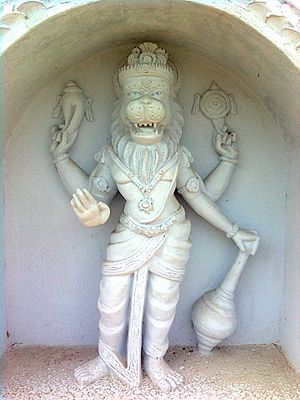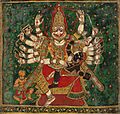Narasimha facts for kids
Narasimha is a very important figure in Hinduism. He is known as the fourth avatar (or special form) of the god Vishnu. In this unique form, Vishnu appears with the body of a man but the powerful head of a lion. Narasimha is a symbol of incredible strength and protection.
Contents
The Story of Narasimha
Hindu stories tell us about Narasimha's special purpose. There was once a powerful demon named Hiranyakashipu. He disliked all gods and wanted everyone to worship only him.
Hiranyakashipu had a son named Prahlad. But Prahlad was different. He loved and worshipped the gods, especially Vishnu. This made his father, Hiranyakashipu, very angry.
Hiranyakashipu's Special Power
Hiranyakashipu wanted to harm Prahlad and stop anyone from worshipping the gods. He thought no one could stop him. This was because the god Brahma had given him a special gift, called a boon.
This boon made Hiranyakashipu believe he was safe from everything. He could not be killed by a human, an animal, or a god (a deva). He also could not be killed during the day or night. And he could not be killed inside or outside his palace.
Vishnu Becomes Narasimha
Because of this boon, Hiranyakashipu felt unbeatable. He tried to kill his son Prahlad for worshipping Vishnu. To protect Prahlad and other good people, Vishnu took on the form of Narasimha.
Narasimha was a half-man, half-lion creature. He was neither fully human nor fully animal. This allowed Vishnu to defeat Hiranyakashipu without breaking Brahma's boon.
Narasimha killed Hiranyakashipu at twilight, which is neither day nor night. He did this on the porch of the palace, which is neither inside nor outside. This clever way allowed Vishnu to protect his followers and restore balance.
Images for kids
-
Vishnu and his avatars (Vaikuntha Chaturmurti): Vishnu himself or Vāsudeva-Krishna in human form, Narasimha as a lion, Varaha as a boar. Art of Mathura, mid-5th century CE. Boston Museum.
-
Narasimha, Chola period, 12th -13th century, Tamil Nadu. from Museum Guimet, Paris.
-
Narasimha sculptures guard an entrance, Banteay Srei temple, Cambodia.
See also
 In Spanish: Narasinja para niños
In Spanish: Narasinja para niños







